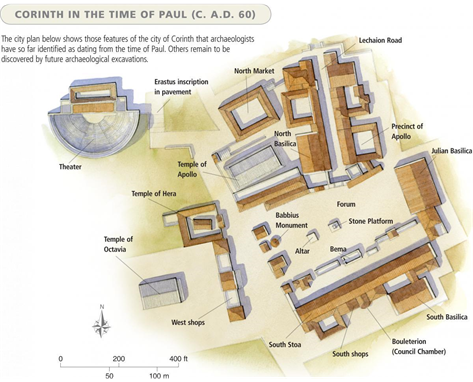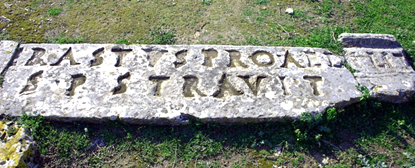The Greek city of Corinth, capital of the Roman province of Achaia, was the Apostle Paul's fifth stop during his third missionary journey into Asia minor and Europe (Acts 16-17). Corinth was powerful as well as prosperous, as it controlled the strategic trade route over land and sea travel lanes. There is no question Corinth existed in biblical times, as there are 33 Greek and Roman authors citing the city in 89 different historical and literary works. Extensive archaeological excavations allow us to re-create the ancient structures seen by the apostle Paul when he was there, including pagan temples, a Bema (an elevated podium used by government officials to publicly judge matters or address a crowd), portions of roads to transport goods across the isthmus, a colonnaded market street, workshops, bathhouse, an odeion (small theater), fountains, houses, and government offices (see map, below). [1]

The most intriguing discovery was that of an inscription on a pavement near the theatre. Dave Stotts of Drive Through History offers this description, as well as a video of other archaeological discoveries from the book of Acts: "During the reign of Emperor Claudius, around the middle of the 1st century AD and perhaps just before 50 AD, an official named Erastus paid for an area near the theater to be paved with stone at Corinth ... The government did not always have the funds to pay for new construction, so wealthy citizens often financed or contributed to projects. To honor the patron who funded the pavement, a section of stone might be inscribed with a name, title, act, and occasionally additional information or reference to an Emperor or deity. In 1929, excavations at Corinth discovered a Latin inscription carved deep into the pavement with 7-inch-tall letters which were originally filled with bronze (see image, below).

It translates as "Erastus in return for his aedileship laid [the pavement] at his own expense." The office of aedile was a high-ranking public office in a city which functioned as the commissioner of public works. This commemorative inscription on the pavement mentions Erastus, his city office of aedile, and that he paid for the section of pavement himself. Erastus ... was a very uncommon name. After the Apostle Paul moved to Corinth in about 50 AD, he met a man named Erastus who soon became a Christian and a friend, and this Erastus was noted as the city manager of Corinth using a Greek description equivalent to the Latin aedile (Erastus the chamberlain of the city saluteth you, Rom. 16:23, cp Acts 19:21-22; 2 Tim. 4:20). The convergence of chronology, uncommon name, location, and his position as a high-ranking official of Corinth indicates this inscription names the Erastus recorded in Acts and two letters of Paul." [2]
[1] History, J. Daniel Hays A Christian's Guide To Evidence for the Bible, Baker Books, 2020, pg. 263-265. Map, Don Doehla, Berkely. We take exception to Don's theology.
[2] Quote, https://drivethruhistory.com/erastus-inscription/. Photo, Holy Land photos. We recommend the "Drive Through History" video series for the family.
Like this? Consider sharing it to Facebook by clicking the linked icon below.
